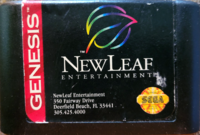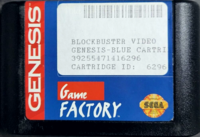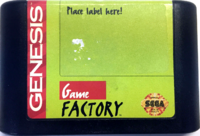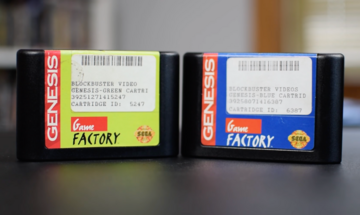Difference between revisions of "Game Factory"
From Sega Retro
m (→History: B.B. FLASH ROM) |
m |
||
| Line 69: | Line 69: | ||
Blockbuster also had trouble signing deals with third-party publishers, and so could initially only offer the service for first-party [[Sega]] games{{magref|egm2|1|28}} and those developed by [[Virgin]] (owned by Blockbuster). The only outside company which ended up licensing its games to the service was [[Acclaim]]. | Blockbuster also had trouble signing deals with third-party publishers, and so could initially only offer the service for first-party [[Sega]] games{{magref|egm2|1|28}} and those developed by [[Virgin]] (owned by Blockbuster). The only outside company which ended up licensing its games to the service was [[Acclaim]]. | ||
| − | The move to optical media and the security features surrounding Saturn and PlayStation video games proved too much of a challenge for the firm, and the service was quietly discontinued at some point in 1995. It is not fully understood what happened to the Game Factory inventory - cartridges have been spotted on online auction sites, and development cartridges have also been seen. | + | The move to optical media and the security features surrounding Saturn and PlayStation video games proved too much of a challenge for the firm, and the service was quietly discontinued at some point in 1995. It is not fully understood what happened to the Game Factory inventory - cartridges have been spotted on online auction sites, and development cartridges have also been seen. After Game Factory's closure, the cartridges were generally flashed with a single game and sold directly to consumers as a form of liquidation{{ref|1=https://www.youtube.com/watch?v=nrUWIHasHPQ}}, frequently with the game's title having been crudely written on the label.{{ref|1=https://drive.google.com/file/d/1KrzXK094OdgcxpcSw6oTspZ65TsaUgaf/view}} |
===Legacy=== | ===Legacy=== | ||
Revision as of 12:57, 21 January 2023

| ||||||||||
| Game Factory | ||||||||||
|---|---|---|---|---|---|---|---|---|---|---|
| Made for: Sega Mega Drive | ||||||||||
| Manufacturer: NewLeaf Entertainment | ||||||||||
| Licensor: Blockbuster | ||||||||||
| Type: Backup tool | ||||||||||
|
This teeny-tiny article needs some work. You can help us by expanding it.
Game Factory was a rewritable Sega Mega Drive cartridge service run by Blockbuster around late 1994, developed through a collaboration between Sega of America and NewLeaf Entertainment. A novel idea in the world of home rentals, the service was highly ambitious and critically well-received, but suffered from a number of problems and had its subsequent nationwide rollout eventually cancelled.
Contents
Service
Manufactured by NewLeaf Entertainment subsidiary Fairway Technologies[1], three different cartridges were available for users to rent games through. Easily most common were the Game Factory-branded green and blue cartridges, equipped with different amounts of internal memory for storing multiple sizes of games.
| Code | Memory size | Description | Image |
|---|---|---|---|
| NL101 | unknown | A NewLeaf Entertainment-branded cartridge with a black label. | 
|
| NL102 | 32Mb | A Game Factory-branded cartridge with a blue label. | 
|
| NL103 | 16Mb | A Game Factory-branded cartridge with a green label. | 
|
List of flashable games
- Earthworm Jim[2]
- The Jungle Book[2]
- The Lion King[2]
- Mighty Morphin Power Rangers[2]
- Monopoly[2]
- Pitfall: The Mayan Adventure[2]
- Spider-Man and Venom: Maximum Carnage
History
Background
| “ | Game rental has become an increasingly important market segment, with estimates at about $1.5 billion a year industrywide. But with nearly 1,000 great Genesis and Game Gear software titles available, it’s tough keeping an inventory broad and deep enough to satisfy peak demand. This system ensures that every customer will be a satisfied customer. | „ |
The concept involved customers renting Sega Mega Drive video games stored on reprogrammable flash cartridges. Avoiding the need to stock potentially hundreds, if not thousands of official video game cartridges for rent, Blockbuster could instead use a Game Factory cartridge, flash the contents of a ROM image onto the memory inside, and distribute that instead. When the customer had finished borrowing the game, the cartridge could then be flashed with another ROM image and be recycled for further use[1].
Launch
The Mega Drive Game Factory was the first of its kind (though the concept of using reprogrammable cartridges is as old as the game cartridge itself, as it is a vital tool for cartridge game development), and was initially offered between the 10th and 15th of August 1994[1] to ten Blockbuster stores in Columbia, South Carolina (alongside at least one store in NewLeaf's hometown of Boca Raton, Florida). The real plan, however, was to gauge interest in whether the concept would be feasible with the upcoming generation of consoles, namely the PlayStation and Sega Saturn. A Sega Game Gear variant was planned[1], but does not appear to have made it to consumers.
Blockbuster had also tried (and failed) to secure deals for other forms of entertainment, such as VHS videos and music CDs, however despite developing the equipment, big publishers were uneasy with the practise and chose not to license their libraries. Some of these fears were mitigated, however, by Viacom's takeover of Blockbuster in 1993.
Reportedly the entire system originated from reverse-engineering Mega Drive cartridges, as Sega wouldn't put their name to it until a proof of concept was created.
The process of reprogramming a cartridge took roughly 45 seconds on hardware built specifically for Blockbuster. Two types of cartridge were offered; a "green" cartridge which could store up to 16 megabits (2MB) and a "blue" cartridge which could hold 32 megabits (4MB), both using similar plastic shells as normal retail games. The cartridge also devotes an area for a printed label, so that Blockbuster staff could easily keep track of their stock. Surprisingly, games available for rent through Game Factory appear to contain different ROMs than their original releases, with titles like The Jungle Book displaying a unique B.B. FLASH ROM message at the title screen to indicate its purpose.[4]
Decline
Though apparently a success, the Game Factory service was not rolled out nationwide, nor to other regions of the world where Blockbuster operated. Aside from the fact that Mega Drive sales were on the decline by the end of 1995, Blockbuster and NewLeaf had a hard time keeping up with the demands of new games, which often included extra features that the Game Factory cartridges couldn't accommodate.
For example, having successfully built and tested 16 megabit carts, the firm was hit with the news that Spider-Man and Venom: Maximum Carnage, a game Blockbuster had signed up to promote, would be released on a 32 megabit cartridge. Other games like Sonic & Knuckles and Virtua Racing were likely skipped entirely, and it is not known if there was compatibility with games which required a battery for saving.
Blockbuster also had trouble signing deals with third-party publishers, and so could initially only offer the service for first-party Sega games[1] and those developed by Virgin (owned by Blockbuster). The only outside company which ended up licensing its games to the service was Acclaim.
The move to optical media and the security features surrounding Saturn and PlayStation video games proved too much of a challenge for the firm, and the service was quietly discontinued at some point in 1995. It is not fully understood what happened to the Game Factory inventory - cartridges have been spotted on online auction sites, and development cartridges have also been seen. After Game Factory's closure, the cartridges were generally flashed with a single game and sold directly to consumers as a form of liquidation[5], frequently with the game's title having been crudely written on the label.[6]
Legacy
Game Factory cartridges appear to use CR2032 batteries to hold onto data. Should these batteries have died in the last twenty years or more, the cartridge's contents may have been wiped, rendering them unusable.
Magazine articles
- Main article: Game Factory/Magazine articles.
Physical scans
External links
- Game Factory: Blockbuster & Sega's On-Demand Game Rentals video essay by Gaming Historian at YouTube
- Remember When Blockbuster Video Tried Burning Game Cartridges On Demand? article by Drew Littrell at Hackaday
References
- ↑ 1.0 1.1 1.2 1.3 1.4 1.5 EGM², "July 1994" (US; 1994-07-19), page 28
- ↑ 2.0 2.1 2.2 2.3 2.4 2.5 https://docs.google.com/spreadsheets/d/1pOsHrcfrjqzgSbIXidj0JfLqgWX-ftIczHX0VcPUcV0/edit?usp=sharing
- ↑ Sega Visions, "August/September 1994" (US; 1994-xx-xx), page 8
- ↑ https://drive.google.com/file/d/1-FI5nZvEHe5jo6HAzIoJ6xz1oIPHLEr-/view
- ↑ https://www.youtube.com/watch?v=nrUWIHasHPQ
- ↑ https://drive.google.com/file/d/1KrzXK094OdgcxpcSw6oTspZ65TsaUgaf/view
